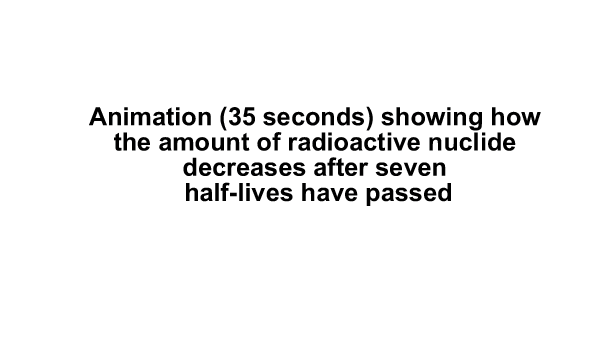Radiation is bombarding us everyday from multiple sources. Radiation comes at us from natural sources and human made sources. Natural radiation comes from are cosmic rays, minerals in the earth's crust and radioactive isotopes of elements incorporated into internal organs in our body. Human sources include medical radiation such as x-rays, consumer radiation such as TSA screening devices, the residue from atmospheric nuclear weapons testing and industrial processes.
Galactic cosmic rays GCR are made up of high energy electrons, protons, and atomic nuclei from our galaxy outside our solar system. For more visit this NASA page click for more .

Radioactive isotopes of elements that are part of naturally occuring minerals make the minerals radioactive. The intensity of the radioactivity depends on the concentration of the isotope and the kind of isotope included in the mineral. Typically minerals that contain potassium (K), uranium (U) and thorium (Th) are radioactive.
Radioactive decay produces Ionizing radiation.
Radiation is a loose term and includes such things as visible light, radio waves, ultraviolet light, and high energy particles capable of ionizing atoms and molecules. The last type is typically called ionizing radiation. When "ionizing" radiation passes through matter, it can knock electrons off of atoms and molecules. It can convert stable nuclei to radioactive isotopes and it can produce electrically charged particles. In living tissues, the electrically charged particles produced by radiation can affect normal biological processes.
There are various types of ionizing radiation, each having different characteristics. The common ionizing radiation types are:
- Alpha particles are helium-4 atoms without their electrons. The alpha particle has a +2 charge. Alpha particles are emitted by atoms of elements such as uranium and radium. Alpha particles can be stopped completely by a sheet of paper or by the thin surface layer of our skin (epidermis). Ingestion or inhalation of alpha-emitting materials can expose internal tissues directly to alpha particles that can cause biological damage.
- Beta particles are high energy electrons. They are more penetrating than alpha particles and can pass through 1-2 centimetres of water. In general, few millimeters thickness of about five to ten layers of household aluminum foil will stop beta particles.
- Gamma rays are very high energy photons or light. Gamma rays, depending on their energy, can pass right through the human body, but can be stopped by thick walls of concrete or lead.
- Neutrons are uncharged particles 0n1and do not directly ionize atoms or molecules. Their interaction with the atoms of matter can give rise to alpha, beta, gamma, or X-rays which then ionize molecules. Neutrons are penetrating and can be stopped only by thick masses of concrete, water or other matter.
You can
estimate your annual radiation dose from all sources using the following link http://epa.gov/radiation/understand/calculate.html or the table below. This table is
adapted from A.R. Hinrichs:
Energy, pp 335-336. Philadelphia, Saunders College Publishing, 1992.
The EPA adheres to a linear no-threshold (LNT) model for radiation exposure. This model assumes that all radiation exposure is harmful and that there is no threshold below which exposure is safe. The LNT theory might be questioned because humanity has experienced cosmic ray and natural radiation exposure forever. The principle behind evolution supposes that over the eons organic changes have occurred in life forms that lead to heartier, more resilient organisms. It would seem that humans should have evolved enough to safely survive the natural, constant, low level cosmic ray and natural radiation bombardment. These sites provide data that raise questions about the validity of the LNT theory and the merits of the alternate radiation hormesis theory.
http://www.21stcenturysciencetech.com/articles/nuclear.html#Case%20of
http://www.wpi.edu/news/20078/radonstudy.html
http://www.ncbi.nlm.nih.gov/pubmed/19066487
This 1998 paper deals with the nonlinearity of radiation effects.
http://www.ncbi.nlm.nih.gov/pmc/articles/PMC1533290/pdf/envhper00536-0363.pdf
Half-life
The half-life of an isotope is the amount of time it takes for half of the radioactive atoms to decay into a more stable nuclide. Naturally abundant radioactive isotopes exist around us only because their half-lives are longer than the age of the earth. Uranium 238 (U-238) has a half-life of 4.5 billion years so it is naturally abundant. Cobalt-60 has a half-life of 5.27 years and is man made Most radioactive isotopes have short half-lives and must be produced in the laboratory to study or use.
Graphic displays for the decrease of radioactive nuclides are shown here. 
http://www.launc.tased.edu.au/online/sciences/PhysSci/done/nuclear/decay/Decay.htm
The amount of radioactive matter will decrease by 1/2 after every half life. This means if we start with 6000 atoms then after one half life there will be 3000 left, after a second half life there will be 1500 atoms left and after a third half life there will be 750 atoms. During these changes the amount of decay products will increase. Decay products like alpha particles do not accumulate. Alpha particles are energetic enough so they can strip electrons off of other particles when they collide. One theory holds that helium in our environment comes from the conversion of alpha particles to helium atoms.
http://www.ncbi.nlm.nih.gov/pmc/articles/PMC1086250/?page=1
Half-life times are unique for each radioactive nuclide.
.

